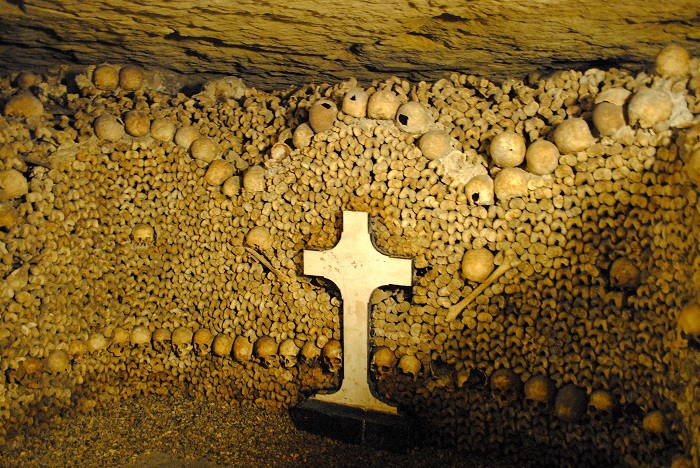Catacomb is an underground cemetery, especially one consisting of tunnels and rooms with recesses dug out for coffins and tombs. You can also define it as an underground crematory where the alive persons can see and touch the bones of dead people. Although there are many catacombs in the world, but the Catacombs of Paris are the most famous among them. It is not a haunted place but it is an example of beautiful artwork done by arranging humans bones and skulls in a beautiful manner. The Catacombs of Paris are underground ossuaries in Paris, France, which hold the remains of more than six million people in a small part of a tunnel network built to consolidate Paris' ancient stone mines. This ossuary was created as part of the effort to eliminate the city's overflowing cemeteries. The Catacombs of Paris are a living cemetery whose walls are made from human bones and skulls. You can even touch these bones and skulls. Here you will see only the bones and skulls of humans around you. The ossuary remained largely forgotten until it became a novelty-place for concerts and other private events in the early 19th century, after further renovations and the construction of accesses around Place Denfert-Rochereau, it was open to public visitation from 1874. Parisians presently often refer to the entire tunnel network as "the catacombs".
Cemeteries whose remains were moved to the Catacombs include Saints-Innocents (the largest by far with about 2 million buried over 600 years of operation), Saint-Étienne-des-Grès (one of the oldest), Madeleine Cemetery, Errancis Cemetery (used for the victims of the French Revolution), and Notre-Dame-des-Blancs-Manteaux. The Holy Innocents Cemetery is a defunct cemetery in Paris that was used from the Middle Ages until the late 18th century. It was the oldest and largest cemetery in Paris. The catacombs in their first years were a disorganised bone repository, but Louis-Étienne Héricart de Thury, director of the Paris Mine Inspection Service from 1810, had renovations done that would transform the underground caverns into a visitable mausoleum.
The Catacombs of Paris became a curiosity for more privileged Parisians from their creation, an early visitor being the Count of Artois during 1787. Public visits began after its renovation into a proper ossuary. Many times these catacombs were closed and reopened during these time periods. After an incident of vandalism, the Catacombs were again closed to the public during September 2009 and reopened on 19 December of the same year.
There were lots of other events happened in the catacombs:-
Cemeteries whose remains were moved to the Catacombs include Saints-Innocents (the largest by far with about 2 million buried over 600 years of operation), Saint-Étienne-des-Grès (one of the oldest), Madeleine Cemetery, Errancis Cemetery (used for the victims of the French Revolution), and Notre-Dame-des-Blancs-Manteaux. The Holy Innocents Cemetery is a defunct cemetery in Paris that was used from the Middle Ages until the late 18th century. It was the oldest and largest cemetery in Paris. The catacombs in their first years were a disorganised bone repository, but Louis-Étienne Héricart de Thury, director of the Paris Mine Inspection Service from 1810, had renovations done that would transform the underground caverns into a visitable mausoleum.
The Catacombs of Paris became a curiosity for more privileged Parisians from their creation, an early visitor being the Count of Artois during 1787. Public visits began after its renovation into a proper ossuary. Many times these catacombs were closed and reopened during these time periods. After an incident of vandalism, the Catacombs were again closed to the public during September 2009 and reopened on 19 December of the same year.
There were lots of other events happened in the catacombs:-
- During World War II, Parisian members of the French Resistance used the tunnel system.
- Bodies of the dead from the riots in the Place de Grève, the Hôtel de Brienne, and Rue Meslée were put in the catacombs on 28 and 29 August 1788.
- During 1871, communards killed a group of monarchists there.
- The tomb of the Val-de-Grâce hospital doorkeeper, Philibert Aspairt, lost in the catacombs during 1793 and found 11 years later, is located in the catacombs on the spot where his body was found.
- During 1974, the film The Holes was filmed and set within the Catacombs of Paris.
















0 comments:
Post a Comment